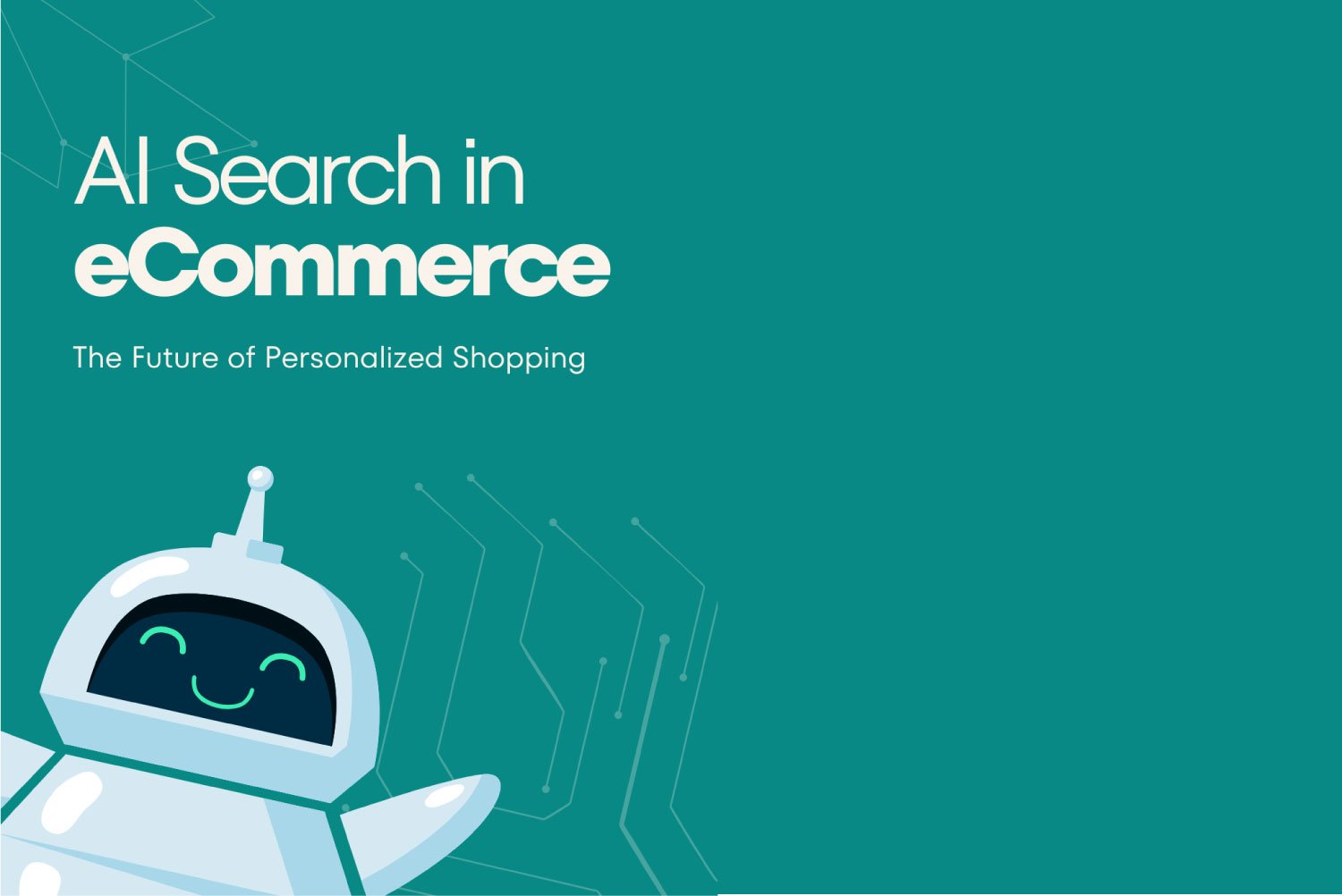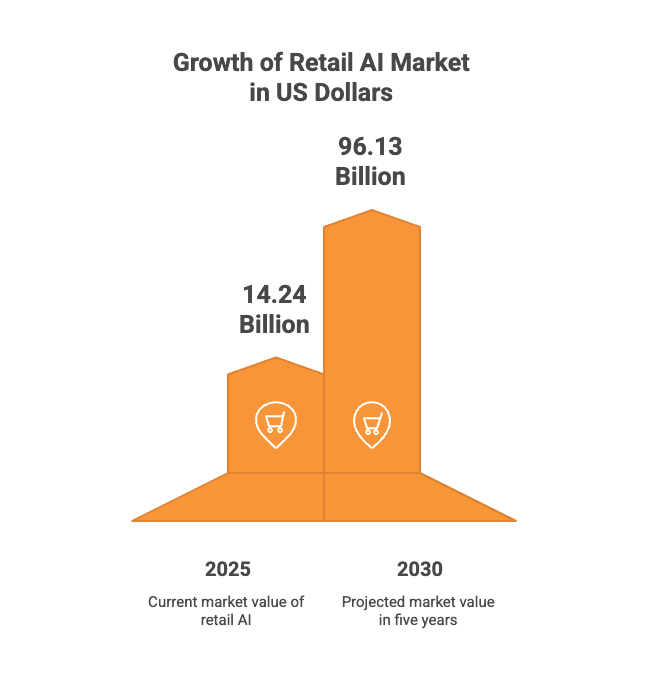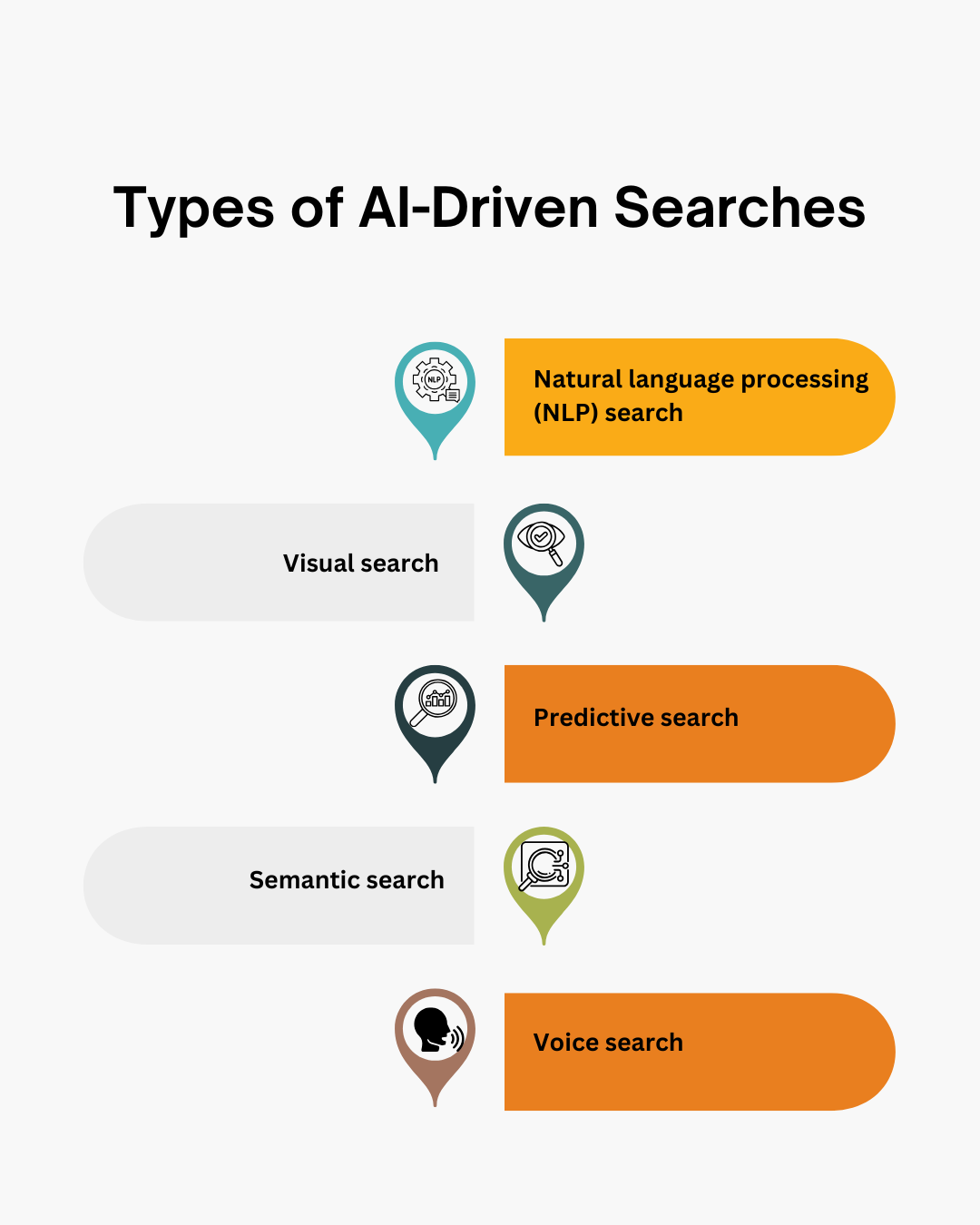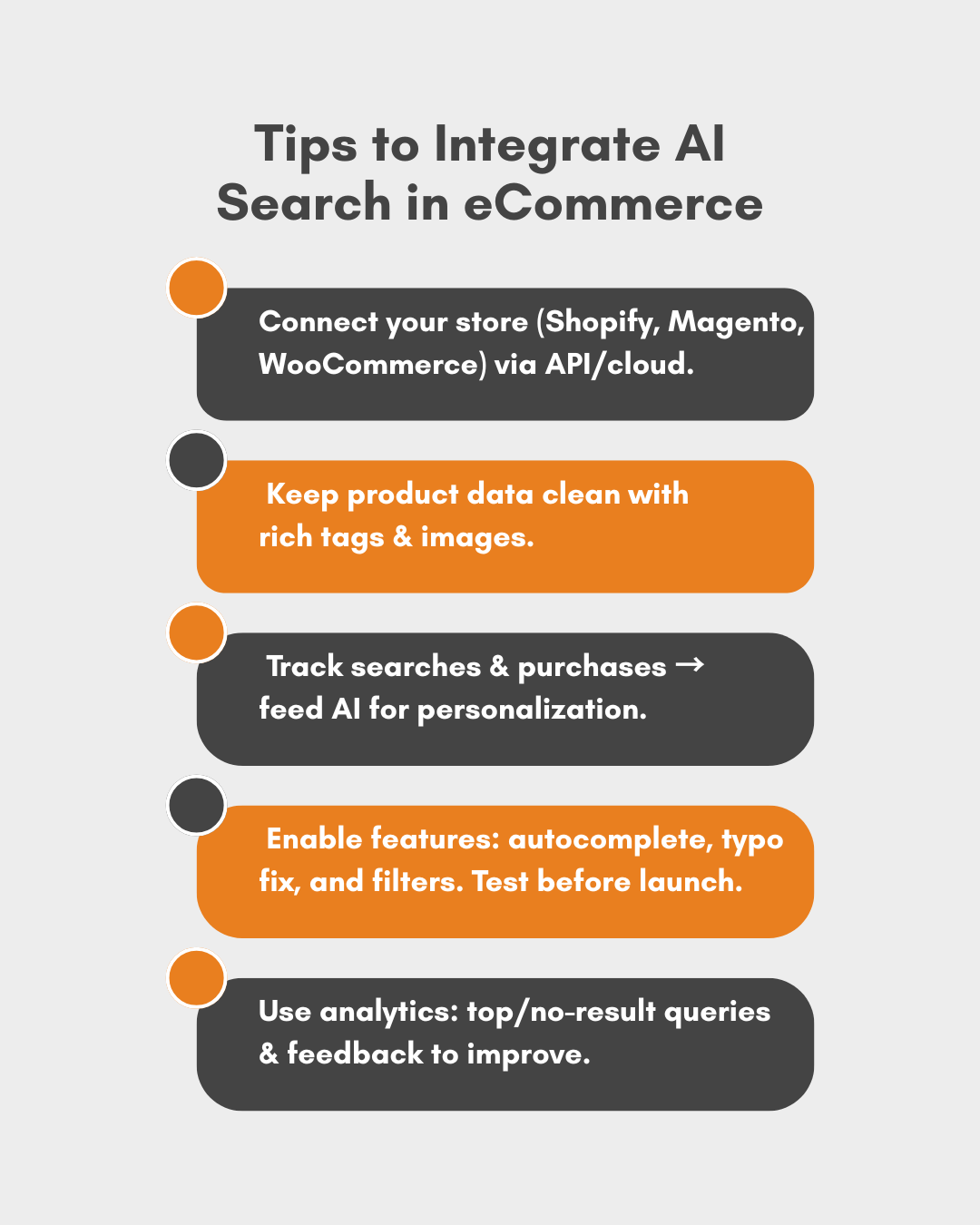Data Warehousing in eCommerce : Transforming Analytics, Customer Insights & Fraud Prevention


Modern retail shoppers don’t simply prefer a personalized experience. They absolutely love it! Be it through online browsing or some casual window shopping, they want a shopping experience that fits their individual styles, preferences, and habits. Who wouldn’t want that?
No wonder 9 out of 10 adults are more loyal to retailers that offer personalized experiences. Brands offering personalized experiences earn 40% more revenue than their peers.
A quick search (by your users) on your store tells you a lot about what someone wants to buy. Here’s how brands can use AI search in eCommerce to make shopping feel more personal for each customer.
AI has changed how customers discover products. Retailers these days are using advanced AI to power their online search feature, making a shift from keyword matching to visual recognition, and personalized recommendations.
The retail AI market is valued at $14.24 billion in 2025. It is estimated to reach $96.13 billion by the year 2030, and 78% of retailers used AI in 2024.

Retail stores are using AI technology in many ways to make the shopping experience for their customers better. AI-enabled search lets customers use phrases used in daily conversation and upload product photos to help them find the right products. This is super useful when they don’t know the names and details of their desired shopping items – They can just quickly find what they are looking for.
AI assistants have now become a common and necessary partner in online shopping. They help customers search for products, answer questions, and give personal suggestions.
Sephora’s Smart Skin Scan is a good example of personalization. This AI tool takes a photo of your skin, analyses it, and then recommends a four-step skincare plan that matches your skin type, whether you have dryness, fine lines, blemishes, or uneven tone. Instead of searching options, shoppers get a list of products made for them.
This shows why personalization is important in eCommerce. It makes shopping easy by removing friction and building trust. Plus, it helps online stores drive sales and revenue. Below, we’ve explained the key benefits of personalization.
When you show customers what they actually want, they buy more. People don’t want to dig through pages of random products – they want to find what makes sense for them. Show them the right products according to their preferences and they’ll add it to their cart.
Take someone who just bought a laptop. They probably need a laptop bag, maybe a wireless mouse, or a screen protector. If you suggest these right after their purchase, they’ll likely grab a few extras since they’re already thinking about their new setup.
People go back to websites that make shopping effortless. If an e-commerce store remembers their favorite items, they’ll love to shop with them. This increases customer trust.
For example, Amazon personalizes shopping by tracking your previous purchases. When you log back in, the website shows recommendations. This makes customers feel that you remember them, which builds trust and retains them.
When customers get products that don’t match what they were looking for, they return them. This costs businesses money in terms of shipping, restocking, and sales. Personalization reduces this by helping customers choose products that fit their needs.
Say you buy a medium shirt and some jeans from an online store. Next time you shop there, they’ll suggest mediums and similar styles instead of making you guess. Means fewer returns when things don’t fit.
When you use personalization tools, you’re not just making customers happier – you’re also getting a goldmine of data about what people actually want. Every click, search, and purchase tells you something. Even the stuff people leave in their cart without buying gives you clues.
Let’s say you run an online store and keep seeing people buy running shoes and fitness trackers together. That’s not random – it’s telling you something about your customers. You can use that info to suggest related products for customer retention, figure out what to stock up on, set better prices, or create ads that actually make sense.
Finding the right product online can be tricky. AI search helps by figuring out what people actually want and showing better results. Here are the main types of AI-powered search that make this happen.

NLP search does more than just match keywords – it figures out what customers actually mean when they search. Instead of showing random stuff, it looks at the whole search to find what people really want.
Say someone searches for “comfortable running shoes for flat feet.” The system knows they need shoes made for flat feet that feel good. Rather than showing every running shoe in stock, it only displays the ones that work for flat feet and focus on comfort.
Visual search lets your customers search for products with images. They just have to upload an image and the search engine will display similar items.
This helps people who don’t know the exact product name find the right items quickly.
For example, like if you see sunglasses in a magazine – just snap a photo, upload it to the store’s site, and find where to buy them. Saves you from trying to describe what you saw to someone who probably won’t get it anyway.
Predictive search enhances customers’ experiences by guessing what the customer is typing and offering suggestions right away.
A great example is Google Search. When you perform a search, you’re shown a list of search terms you may be interested in. This speeds up the search and saves you time. E-commerce website owners are implementing a small feature using AI technology.
Semantic search works differently from basic keyword matching – it actually understands what shoppers are looking for, not just the specific words they type.
Regular search engines match exact words. But semantic search figures out the real meaning behind a search and how different terms relate to each other.
Take searching for “shoes for summer beach party” as an example. A basic search might show any shoes that happen to mention those words somewhere in their description. Semantic search is smarter – it knows you probably want sandals, flip-flops, or light casual shoes that actually make sense for that situation.
Voice search enables customers to use spoken language, known as voice commands to search and shop. It makes shopping hands-free and easy.
For example, a customer might say, “Find me a black leather jacket under $200,”. AI algorithms will process this natural speech and show similar products.
AI search isn’t just about finding products. It engages customers and makes them come back for more. When shoppers feel valued and understood, they’re more likely to return. Here’s how AI search in eCommerce helps:
Search works the same way. If customers can’t find products, they won’t stay and look for other brands. Here’s where AI search in eCommerce plays an important role in engaging and retaining them. Bononos, a clothing brand, replaced its existing product discovery process with an AI-powered recommendation engine. The brand saw impressive results, a 92% increase in recommendation conversions and 22% increase in recommendations AOV.
AI search in eCommerce offers a consistent experience across multiple touchpoints.
AI search in eCommerce and recommendation engines is changing how people shop online – making it quicker and easier for customers to find what they actually want. Getting this right can make your store stand out and bring in more sales. Here are some key tips to help you add AI search in eCommerce to your site without any headaches and really make it work for you.

1. Connect your online store, like Shopify, Magento, or WooCommerce, with an AI search tool using cloud integration or API.
2. Create clean and structured product catalogs with descriptions, images, and relevant tags.
3. Track customer activities such as searches and purchases. Send this data to AI engines so they give personalized recommendations. You can also import historical data to train models.
4. Set up advanced features such as autocomplete, synonym handling, typo correction, and dynamic filters. Perform A/B testing to validate configurations before going live.
5. Use built-in analytics to improve the search ranking algorithm. Check search analytics such as top searches, searches with no results, and abandoned searches.
6. Your AI search needs to work better on mobile phones – most people shop on mobile these days and hate waiting for slow searches.
7. Show locals stuff that makes sense for them. Someone in New York doesn’t need to see winter coats in July.
8. Update your product info or your AI search will show things you don’t even sell anymore.
9. Let people search in whatever language they want. Pretty basic if you want international customers.
10. Don’t make filtering complicated. People should be able to narrow down AI results without a manual.
Here are a few leading brands that are using AI search to transform customer experiences.
Volkswagen deployed a generative AI-powered myVW virtual assistant within its myVW mobile app. This assistant is for MY24 Atlas and Atlas Cross Sport owners and helps them get important information and services.
Zalando, one of Europe’s biggest online fashion retailers, creates personalized shopping experiences by tracking what customers browse, buy, and like. The platform then suggests products that match each person’s style.
Shopify now offers Semantic Search, an AI-powered tool in the Search & Discovery app. Unlike a normal keyword search, Semantic Search understands the intent of a shopper. For example, a customer can type, “What lipstick should I wear for a pastel dress?” and get matching results.
Nordstrom, a department store company, uses AI to make fashion more fun and appealing for its customers. In its refreshed app, it rolled out a new feature named trend reports, to blend the expertise of Nordstrom’s stylists with generative AI to offer relevant trends. Customers can use the Style Swipes feature to make product recommendations based on their purchase habits and preferences.
To summarize, a powerful search capability can help customers find and buy their favorite products. From hyper-personalized shopping experiences to building customer loyalty, AI in the e-commerce sector is already transforming the way shoppers buy the products.
With its range of AI expertise, RBM Software can help you deliver a personalized shopping experience to your consumers. Connect with us if you’re preparing for the next wave of innovation in AI technology.